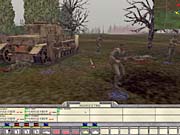Making a wargame these days is a difficult undertaking. On the one hand, you've got to satisfy hard-core wargame fans with solid gameplay and historical fidelity. On the other hand, you really should to try to rope in new players with something flashy or innovative. Most wargames veer toward one of those two approaches. Unfortunately, Freedom Games' G.I. Combat veers so far afield that it's practically AWOL.

One of the few things you can say in G.I. Combat's favor is that it has a respectable pedigree. It was created by some of the developers of Atomic's Close Combat, one of the earliest attempts to bring the tension of real-time strategy to a traditional wargame. In its day, Close Combat was a breath of fresh air, a thrilling lesson in dealing with factors like suppressing fire and morale. It looked good and sounded great, although it dragged on through about two sequels too many.
But G.I. Combat has none of Close Combat's innovation or bold design. It bears a lot of similarities to that venerable series, as if the developers couldn't quite break away from the same game they've been working on for the last six years or so. For instance, you select unit orders exactly as you did in Close Combat, and you even use the bottom row of your keyboard for shortcut keys, just like in Close Combat. The individual debriefings between missions are right out of Close Combat. The setting--Normandy immediately after the D-Day landing--is a return to Close Combat's roots. The game's structure, which basically involves a short series of linked scenarios with your men carrying over between missions, is similar to that of Close Combat. All these elements will perhaps be familiar or even nostalgic for fans of Atomic's games, but they're nevertheless the product of a clunky 3D engine slapped on top of a game design from six years ago.
G.I. Combat's biggest shortcoming is that it has very little gameplay. Instead, it has a heap of confusion. Once you place your units for a battle and press the start button, you're on a confusing ride to the end of the time limit. You can give your squads and vehicles orders, but the game plays in relentless real time, and it doesn't give you enough information about what your men are doing, where they're going, or even what they are. The selection of orders you can give is limited, and they often get overridden by the tactical AI for reasons that aren't always clear. You can't always tell when a unit can see another unit. You can't easily tell when someone is under fire. Sometimes, you won't even be able to find a unit or squad. Once the firing starts, men start shouting and tracers dot the landscape. Sometimes something burns or gives off smoke. People die often. Tanks blow up. If you give enough movement orders, it's possible you might eventually grab a victory location. It might realistically model the chaos and confusion of a real-world skirmish, but it's hardly playable.
G.I. Combat's interface is partly to blame. You can select only one vehicle or squad at a time, and your orders consist of a few broad instructions. The awkward camera control conspires with the awkward unit interaction to make it even harder to tell what's going on. If pausing didn't completely lock you out of the game, you might have had a chance to consider your situation better and occasionally find your men among the pixelated foliage. Instead, you just hang on and wait for the scenario to end.
Hopefully the AI enjoys playing the game, because it controls most of G.I. Combat. The AI exhibits a bewildering range of behavior, from waltzing into enemy fire like a suicide squad to executing strange flanking maneuvers that might pass for smart tactics if they weren't so erratic. The friendly AI is mostly frustrating for not always seeking cover when it should. It's not uncommon for men under fire to decide to stand up and get shot for no reason. Since you can't place individual men, it's almost impossible to get soldiers to take cover in a house without having a few men dawdling around outside. At least tanks seem to err on the side of caution and thus extend their longevity.
G.I. Combat's graphics are dated, and its colors are drab and muddy. Although the tank models are decent, they're not as good as Combat Mission's latest 3D models. The infantry models feature passable artwork but very jerky animation. The terrain is murky, and special effects like smoke and fire are extremely bad. G.I. Combat's appearance represents one of the worst uses of a 3D graphics engine in a wargame since Panzer General clogged up your screen with inscrutable little polygonal models. Most of the sound effects are disappointingly tinny, and you get a lot of obvious repetition, particularly when your men scream after getting shot.

G.I. Combat gives you a lot of options for setting up missions, which can be played singly or linked together as short campaigns. Most of the maps are small, so battles usually start out with units within firing range. Hedgerows tend to divide the small maps into even smaller killing zones. But without finer control over your units or a better AI, it's hard to carefully negotiate these obstacles. At least there's some degree of replay value in that most missions give you points to spend on different types of additional forces.
Unfortunately, there's not much reason to play the missions, much less replay them. Freedom Games may be able to address some of G.I. Combat's problems with diligent patching. But in the meantime, there's really no reason to be playing this instead of the far superior Combat Mission, which inspired it.